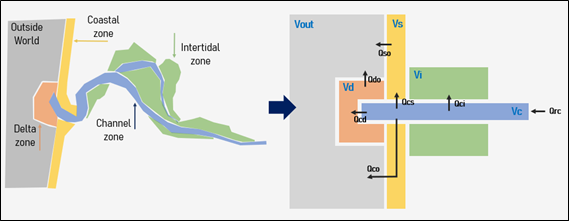M. Reyes1*,M. Van der Wegen2 , J. Reyns3
1 IHE Delft, Netherlands; 2 IHE Delft, Netherlands; 3 IHE Delft, Netherlands
*mreyec@uni.pe
Introduction
Estuaries, where fresh water mixes with salt water under the influence of the tides, are home to a rich variety of marine life (IPCC, 2023). However, they face increasing vulnerability due to coastal development driven by climate change. Rising temperatures and sea levels have significantly affected estuaries, increasing their susceptibility to adverse outcomes. The Intergovernmental Panel on Climate Change (IPCC) reports highlight the sensitivity of estuaries and lagoons to these changes, which can lead to various adverse consequences. In order to develop a comprehensive study, it is crucial to understand the modelling challenges involved. Bamunawala et al. (2020) emphasize the importance of recognizing the complexity of the variables that impact the evolution of these challenges over time. In particular, the morphodynamic behavior of intertidal area under SLR scenarios remains a matter of concern and tools are needed to assess first order SLR impact when limited data are available.
Objective and Methods
The study examines the influence of sea level changes and sediment supply on estuarine morphodynamics in the light of climate change. The research applies the newly developed morQuest Matlab/Python code to assess SLR impact and comprehensively analyze morphodynamic responses for different estuaries along the US Westcoast. MorQuest was developed to make a first order morphodynamic assessment of estuaries under SLR in the absence of data required for more advanced modeling systems like ASMITA or Delft3D.
We carried out an extensive sensitivity analysis on model parameters, a calibration against historic data on the US Westcoast, and projections for SLR scenarios. In the sensitivity phase, we identify and prioritize the most sensitive model variables, focusing on the factors that govern sediment transport and distribution. During the calibration phase, we determine characteristic parameters of the area, with sea level rise being the main factor. Finally, a projection analysis predicted how rising sea levels would impact estuaries. By projecting these scenarios into the future, we gained valuable insights into how these crucial ecosystems respond to environmental changes. This knowledge informs adaptation and mitigation strategies. The morQuest code potentially emerges as a crucial tool for informed decision-making to sustain estuaries amidst changing environmental conditions.
Results
The study's findings offer an understanding of the dynamics shaping estuarine ecosystems along the U.S. West Coast in the face of climate change. Over the period from 1984 to 2016, notable trends emerged, including a decline in intertidal areas across several estuaries, albeit with exceptions such as the Coquille River and Nestucca Bay. Intriguing variations were observed, particularly in Siletz Bay, where, despite no significant changes in the intertidal area, a consistent decrease over time was noted, marked by the disappearance and emergence of the specific regions.
The morQuest model proved instrumental in assessing estuarine responses to climate change, particularly in identifying sensitive parameters and proposing resilience-enhancing strategies. Sensitivity analysis highlighted the crucial, but underexplored role of parameters related to the intertidal area width response to SLR. In contrast, uncertainty analysis underscored the importance of considering scenarios applicable to urbanized areas and the predominant influence of sea level rise on estuarine behavior. Projections suggest varying timelines for the loss of the intertidal regions across different estuaries, with Nehalem estuaries expected to be impacted within 50 years and others even sooner. However, uncertainties persist, particularly regarding sediment supply dynamics, necessitating further investigation for more robust management strategies in safeguarding these vital coastal ecosystems.

Scheme of elements inside of the morQuest Code.
References
- Bamunawala J, Dastgheib A, Ranasinghe R, van der Spek A, Maskey S, Murray AB, Duong TM, Barnard PLandSirisena TAJG (2020) A Holistic Modeling Approach to Project the Evolution of Inlet-Interrupted Coastlines Over the 21st Century. Frontiers in Marine Science 7 DOI 10.3389/fmars.2020.00542
- IPCC (2023) Climate Change 2021 – The Physical Science Basis: Working Group I Contribution to the Sixth Assessment Report of the Intergovernmental Panel on Climate Change Cambridge University Press, Cambridge.


